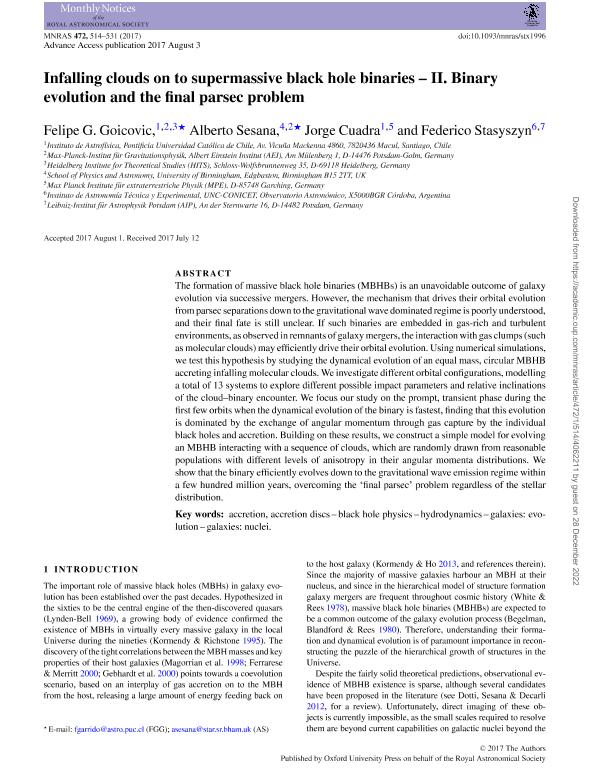Artículo
Infalling clouds on to supermassive black hole binaries - II. Binary evolution and the final parsec problem
Fecha de publicación:
11/2017
Editorial:
Wiley Blackwell Publishing, Inc
Revista:
Monthly Notices of the Royal Astronomical Society
ISSN:
0035-8711
e-ISSN:
1365-2966
Idioma:
Inglés
Tipo de recurso:
Artículo publicado
Clasificación temática:
Resumen
The formation of massive black hole binaries (MBHBs) is an unavoidable outcome of galaxy evolution via successive mergers. However, the mechanism that drives their orbital evolution from parsec separations down to the gravitationalwave dominated regime is poorly understood, and their final fate is still unclear. If such binaries are embedded in gas-rich and turbulent environments, as observed in remnants of galaxy mergers, the interactionwith gas clumps (such as molecular clouds)may efficiently drive their orbital evolution. Using numerical simulations, we test this hypothesis by studying the dynamical evolution of an equal mass, circular MBHB accreting infallingmolecular clouds.We investigate different orbital configurations,modelling a total of 13 systems to explore different possible impact parameters and relative inclinations of the cloud-binary encounter. We focus our study on the prompt, transient phase during the first few orbits when the dynamical evolution of the binary is fastest, finding that this evolution is dominated by the exchange of angular momentum through gas capture by the individual black holes and accretion. Building on these results, we construct a simple model for evolving an MBHB interacting with a sequence of clouds, which are randomly drawn from reasonable populations with different levels of anisotropy in their angular momenta distributions. We show that the binary efficiently evolves down to the gravitational wave emission regime within a few hundred million years, overcoming the 'final parsec' problem regardless of the stellar distribution.
Archivos asociados
Licencia
Identificadores
Colecciones
Articulos(IATE)
Articulos de INST.DE ASTRONOMIA TEORICA Y EXPERIMENTAL
Articulos de INST.DE ASTRONOMIA TEORICA Y EXPERIMENTAL
Citación
Goicovic, Felipe G.; Sesana, Alberto; Cuadra, Jorge; Stasyszyn, Federico Andres; Infalling clouds on to supermassive black hole binaries - II. Binary evolution and the final parsec problem; Wiley Blackwell Publishing, Inc; Monthly Notices of the Royal Astronomical Society; 472; 1; 11-2017; 514-531
Compartir
Altmétricas




